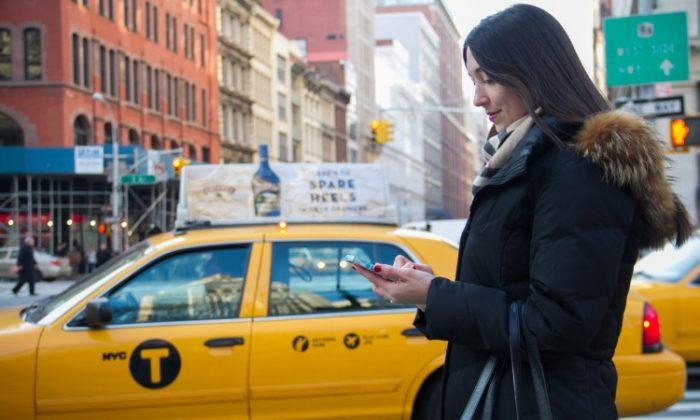NEW YORK—A taxi driver sees an alert pop up on a screen attached to his dashboard, signaling he has been digitally hailed. Distracted by the device, he crashes.
Another driver in a different area of Manhattan’s Central Business District (below 96th Street) sees the same alert but pulls over before accepting the “e-hail.” Five blocks and several minutes later, the passenger and driver are connected.
These two scenarios illustrate the intense debate surrounding a thorny issue that has engaged key groups in the city’s taxicab and for-hire car industry.
The only way to hail yellow cabs now is by throwing a hand up on the street and hoping one passes by that is empty.
Livery and black cabs on the other hand, accept prearranged pickups both through phone calls and smartphone applications (apps), but are not legally allowed to pick up street hails.
TLC officials said Thursday at a public hearing on proposed rules that potential issues, such as making sure only licensed drivers could be hailed through apps, were being addressed. Also, payments using apps would need to be funneled through the core electronic payment system known as Technology Passenger Enhancements Project (T-PEP).
TLC officials also seek to make sure drivers don’t drive distractedly poking at a smartphone or tablet by mandating that drivers can’t use the proposed technology unless the vehicle is stationary.
Benefits for allowing new hailing technology include reduced wait times for New Yorkers looking for a taxi. Riders can also look forward to the possibility of getting more trips outside of Manhattan, because drivers would hypothetically be able to find a new fare after they drop their passenger off, a current fear. For drivers, the technology promises more efficient cruising for drivers, said Ashwini Chhabra, deputy commissioner of the TLC.
Taxi drivers who support the e-hailing proposal sat in two rows at a meeting at 125 Worth St., near City Hall with yellow Hailo shirts. Hailo is a one-year-old company that already operates an e-hailing app in cities like London, Boston, and Chicago.
“Every 10 seconds across the world a licensed taxi driver accepts a Hailo e-hail. And with each match we help chip away the millions of dollars lost by drivers and hours wasted by passengers,” said Jay Bregman, founder and CEO of Hailo.
TLC officials said in a typical 12-hour shift, taxi drivers have passengers in the taxi for four hours, but spend almost five hours cruising around looking for passengers. The remainder includes an estimated one-hour commute to and from home and 2.2 hours in breaks.
But commissioner David Yassky said that not all drivers would use apps, and those that do would not use them all the time.
“They will use [an app] if they think it will get them a passenger faster at that particular moment, at that location, than cruising,” he told the dozens of people listening.
Yassky and other TLC officials have involved different stakeholders, which include yellow cab drivers, black cab owners, and app companies. They have had 18 meetings over the last three weeks with different groups. The black cab industry staunchly opposes letting yellow cab drivers and passengers use apps.
“Our deciding principle needs to be in the public interest, rather than any particular private interest,” said Chhabra, citing figures gleaned through a survey from taxi passengers inside taxis that 70 percent of passengers have smartphones and 55 percent want the ability to e-hail taxis and pay by smartphone.
Two industry representatives warned that letting the proposal pass would take the industry back to the dark days of the early 1980s, when all taxis had radios. Taxi drivers were known to spend a lot of time on the radios, and they used to use being on the radio as an excuse to bypass some people looking to hail a ride.
“The person who gets the taxicab hailed [through an app] comes from maybe a comfortable restaurant, while the person who cannot afford a smartphone is left standing outside in the cold as empty taxis pass her by,” said Ira Goldstein, executive director of the Black Car Fund, who later added the proposed rule changes are “arbitrary and capricious” and violate several different laws.
Another concern of black cab owners and drivers is that yellow cabs are getting an unfair advantage. An even playing field would mean black cabs should also legally be allowed to accept street hails.
Others invested in the proposal agree with its essence, but cautioned TLC officials against moving too quickly. “We strongly urge this commission to proceed, but proceed carefully,” said Ethan Gerber of the Greater New York Taxi Association, representing medallion (license) owners. The commission is tentatively planning a vote on Dec. 13.
Jing Wang Herman, CEO of GetTaxi USA, agrees. Herman’s firm and Hailo appear poised to rise to the top if the current market plan by the TLC of regulating the market but letting the market decide which companies will ultimately stay in business (instead of granting exclusive contract(s)) passes.
Herman says the T-PEP system (the electronic payment processing and connected meter) wouldn’t fully be utilized under current rules, such as not mandating automatic fare input.
“Really it’s better to get it right the first time instead of rushing rules in order for the sake of getting something passed.” Herman said. “It’s more important not to take a step than take a step in the wrong direction.”
The Epoch Times publishes in 35 countries and in 19 languages. Subscribe to our e-newsletter.
Please send news tips to [email protected]














Friends Read Free